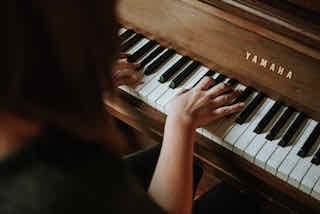Today I read an opinion piece in the New York Times exploring music education. The article proclaims "We're Teaching Music To Kids All Wrong" and asks "Is There A Better Way To Teach It?" Well, there is a way to teach music better. But it's not discussed in the article.
Sammy Miller, the author of the piece, appears to be well-intentioned but paragraphs loosely alternate between making great points and then drawing the wrong conclusions from those points. Here’s my well-intentioned point by point response to what works and doesn't work in Mr. Miller's article.
Paragraph 2: “The fact that many children don't stick with music is bad news... for education.” This is absolutely irrelevant for how we can more effectively teach music to kids. Children will not learn music from our desire to help them with science, English, and math scores and our desire to make them want to [go into debt to] attend college.
Music does not exist to service other subjects. That devalues music. Kids learn music by being engaged in music. When we are in music, there are no other subjects. We should teach science and math better so kids will do better in music.
Then Mr. Miller talks about grown-ups who regret quitting music, and questions why we haven't been better able to encourage kids to continue. Encouragement has nothing to do with it. When we engage kids with music, they don't need encouragement.
You don't have to encourage kids to jump in a mud puddle. You also don't have to encourage them to move weirdly with music or make cool vocalizations. Skilled teachers mold that behavior over time into a vocabulary of rhythm and tonal patterns. Teachers and adults don't need to encourage better. We need to serve kids better.
Paragraph 3: "There is no magical fix." There is. Focus on their musical understanding as the basis for performance skills. There's knowledge on how to do this but it hasn't made it broadly into the field. A few teachers I know are changing that.
We teach kids as if they’ll become musical after they do a bunch of great performances. That’s backwards. When we recognize the music they embody RIGHT NOW, we put ourselves in a powerful position to guide them on their musical journey.
Paragraph 4: “The onus is on parents and educators…” Yes, it is. Kids are gonna kid. Teachers need to up their game and parents need to allow teachers to be experts.
Paragraph 5: “students in low-income and ethnically diverse school districts are more likely to lack access.” Right on the money. A solution that doesn’t account for low-income and ethnically diverse students is not a solution.
Paragraph 6: “affluent kids who…will do anything to make that after-school cello lesson they secretly hate.” Yes, private lessons are more accessible for rich kids. But the truth is those kids are failed in their lessons about as much as other kids.
Modern lessons are geared for the 1 or 2 percent of students with very high musical aptitudes. These are kids who are going to learn music no matter what. Other kids (rich and poor) learn that music is uninteresting. Or that they’re unmusical. The wrong things!
Paragraph 7: “teaching to…the holiday concert.” Right on the money! We’ve fallen into a habit of producing recitals and concerts for parents. For funding. Not for giving students what they need in order to develop musically.
But the gods are in the details. Helping kids doesn’t start with “just one chord, a funky beat, and let[ting] it rip.”
This is technical but getting this wrong means kids fail. There are steps we need to go through before a “chord” will have any meaning. Kids are prepared for learning “a chord” by listening to songs and singing. During that process great teachers help them make connections with pitch relationships. This is fairly complex…FOR TEACHERS. When it’s done skillfully it’s seamless and fun for students.
A funky beat or any other kind of beat won’t make sense to students until they learn to coordinate their movement with both big beats and little beats. That means first moving without a beat—moving with flow.
Paragraph 8: “When we learn language, we don’t simply memorize phrases…” Absolutely right. Music is sharing. We learn it together. We learn it creatively.
Paragraph 9: “We need to let kids be terrible. In fact, we should encourage it. They’ll be plenty terrible on their own—at first.” …Kind of? They’re only “terrible” when we adults judge them so. That judgment will stifle them even if we do our best not to verbalize it. We have to remember it’s not terrible not to have yet learned to coordinate movement and vocalization. It’s a necessary part of the process.
We don’t think it’s terrible when infants babble on their way to learning language.
Paragraph 10: “Watch them get excited to fail.” This is not a great guiding principle for teachers. In fact, it’s sad. Students do need to create over and over in order to learn “what goes well together.” They do not need to experience that process as failure. Great teaching helps them experience that process as love for themselves. Love for each other. And love for music.
Paragraph 11: I love this paragraph. “Parents…don’t let instrument instruction simply be something you nag your kids to endure.” This is so right. Instrumental instruction so often turns into nagging lessons. It’s currently the norm! We (parents and teachers) can do better.
Unlike the author, I have never been nominated for a Grammy. Like the author, I am the founder of a music education company. My Music Genesis, launching next February. Now I’m going to go jump in some mud puddles.

